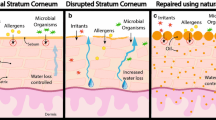Abstract
This study aimed to investigate the effect of glycerol as an Optical Clearing Agent on the temperature profile of the skin during HyperThermic Laser Lipolysis using computer simulation. In this study, a three-layer model of the skin was used to simulate HyperThermic Laser Lipolysis. The Monte Carlo MCML code was used to investigate the propagation of laser photons inside skin tissue. The energy absorbed from photons is used as a heat source to determine the increase in temperature and assess thermal damage in the layers of the skin. The finite element method in COMSOL software was used for calculation. The simulation of single-pulse radiation exposure with and without applying glycerol to the skin model was investigated to assess the impact of glycerol. Glycerol decreases the temperature and thermal damage to the epidermis layer while increasing the temperature of the fat layer. Moreover, the presence of glycerol increases the depth of fat cell destruction. Glycerol, as a supplement, significantly improves the efficacy of HyperThermic Laser Lipolysis.





Similar content being viewed by others
References
Aesthetic Plastic Surgery Statistics Report 2020-2021, (2023). https://www.theaestheticsociety.org/media/procedural-statistics
Apfelberg DB (1996) Results of multicenter study of laser-assisted liposuction. Clin Plast Surg 23(4):713–719
Goldman A, Schavelzon D, Blugerman G (2001) Laserlipolysis: liposuction using nd-yag laser. Revista Brasileira de Cirurgia Plástica 17(1):17–26
Neira R, Ortiz-Neira C (2002) Low-level laser-assisted liposculpture: clinical report of 700 cases. Aesthet Surg J 22(5):451–455
Badin A, Moraes L, Gondek L, Chiaratti M, Canta L (2002) Laser lipolysis: flaccidity under control. Aesthetic Plast Surg 26:335–339
Badin AZE, Gondek LB, Garcia MJ, Valle LCD, Flizikowski FB, Noronha L (2005) Analysis of laser lipolysis effects on human tissue samples obtained from liposuction. Aesthetic Plast Surg 29:281–286
Ichikawa K, Miyasaka M, Tanaka R, Tanino R, Mizukami K, Wakaki M (2005) Histologic evaluation of the pulsed nd: Yag laser for laser lipolysis. Lasers Surg Med 36(1):43–46
Reynaud JP, Skibinski M, Wassmer B, Rochon P, Mordon S (2009) Lipolysis using a 980-nm diode laser: a retrospective analysis of 534 procedures. Aesthetic Plast Surg 33:28–36
Dibernardo BE, Reyes J, Chen B (2009) Evaluation of tissue thermal effects from 1064/1320-nm laser-assisted lipolysis and its clinical implications. J Cosmet Laser Ther 11(2):62–69
Bellini E, Grieco MP, Raposio E (2017) A journey through liposuction and liposculture. Ann Med Surg 24:53–60
Milanic M, Muc BT, Jezersek M, Lukac M (2018) Experimental and numerical assessment of hyperthermic laser lipolysis with 1,064 nm nd: Yag laser on a porcine fatty tissue model. Lasers Surg Med 50(2):125–136
Schilling L, Saedi N, Weiss R (2017) 1060 nm diode hyperthermic laser lipolysis: The latest in non-invasive body contouring. J Drugs Dermatol. 16(1):48–52
Decorato JW, Chen B, Sierra R (2017) Subcutaneous adipose tissue response to a non-invasive hyperthermic treatment using a 1,060 nm laser. Lasers Surg Med 49(5):480–489
Wanner M, Avram M, Gagnon D, Mihm MC Jr, Zurakowski D, Watanabe K, Tannous Z, Anderson RR, Manstein D (2009) Effects of non-invasive, 1,210 nm laser exposure on adipose tissue: Results of a human pilot study. Lasers Surg Med 41(6):401–407
Katz B, Doherty S (2018) Safety and efficacy of a noninvasive 1,060-nm diode laser for fat reduction of the flanks. Dermatol Surg 44(3):388–396
Vas K, Besenyi Z, Urbán S, Badawi A, Pávics L, Erős G, Kemény L (2019) Efficacy and safety of long pulse 1064 and 2940 nm lasers in noninvasive lipolysis and skin tightening. J Biophotonics 12(9):201900083
Oliveira LMC, Tuchin VV, Oliveira LMC, Tuchin VV (2019) Optical clearing and tissue imaging. A New Tool for Clinical Practice and Biomedical Engineering, The Optical Clearing Method, pp 107–138
Deng Z, Liu C, Tao W, Zhu D (2011) Improvement of skin optical clearing efficacy by topical treatment of glycerol at different temperatures. In: Journal of Physics: Conference Series, vol. 277, p. 012007. IOP Publishing
Lai JH, Liao EY, Liao YH, Sun CK (2021) Investigating the optical clearing effects of 50% glycerol in ex vivo human skin by harmonic generation microscopy. Sci Rep 11(1):329
Liu C, Zhi Z, Tuchin VV, Luo Q, Zhu D (2010) Enhancement of skin optical clearing efficacy using photo-irradiation. Lasers Surg Med. 42(2):132–140
Genin VD, Genina EA, Tuchin VV, Bashkatov AN (2021) Glycerol effects on optical, weight and geometrical properties of skin tissue. J Innov Opt Health Sci 14(05):2142006
Oliveira LMC, Tuchin VV, Oliveira LMC, Tuchin VV (2019) Controlling the optical properties of biological materials. A New Tool for Clinical Practice and Biomedical Engineering, The Optical Clearing Method, pp 17–34
Chen B, Zhang Y, Li D (2018) Numerical investigation of the thermal response to skin tissue during laser lipolysis. J Therm Sci 27:470–478
Yu T, Wen X, Tuchin VV, Luo Q, Zhu D (2011) Quantitative analysis of dehydration in porcine skin for assessing mechanism of optical clearing. J Biomed Opt 16(9):095002–095002
Salomatina E, Jiang B, Novak J, Yaroslavsky AN (2006) Optical properties of normal and cancerous human skin in the visible and near-infrared spectral range. J Biomed Opt 11(6):064026–064026
Pearce J (2018) Irreversible tissue thermal alterations: Skin burns, thermal damage and cell death. Theory and applications of heat transfer in humans 2:553–590
Bost C (2019) Heat transfer in biological tissue with thermal damage analysis. COMSOL Blog
Author information
Authors and Affiliations
Corresponding author
Ethics declarations
All authors certify that they have no affiliations with or involvement in any organization or entity with any financial interest or non-financial interest in the subject matter or materials discussed in this manuscript.
Rights and permissions
Springer Nature or its licensor (e.g. a society or other partner) holds exclusive rights to this article under a publishing agreement with the author(s) or other rightsholder(s); author self-archiving of the accepted manuscript version of this article is solely governed by the terms of such publishing agreement and applicable law.
About this article
Cite this article
Vahidian, A., Momayezan Marnani, P., Mehdizadeh, A. et al. Evaluating the effect of glycerol on increasing the safety and efficiency of hyperthermic laser lipolysis. Lasers Med Sci 39, 84 (2024). https://doi.org/10.1007/s10103-024-04029-8
Received:
Accepted:
Published:
DOI: https://doi.org/10.1007/s10103-024-04029-8




